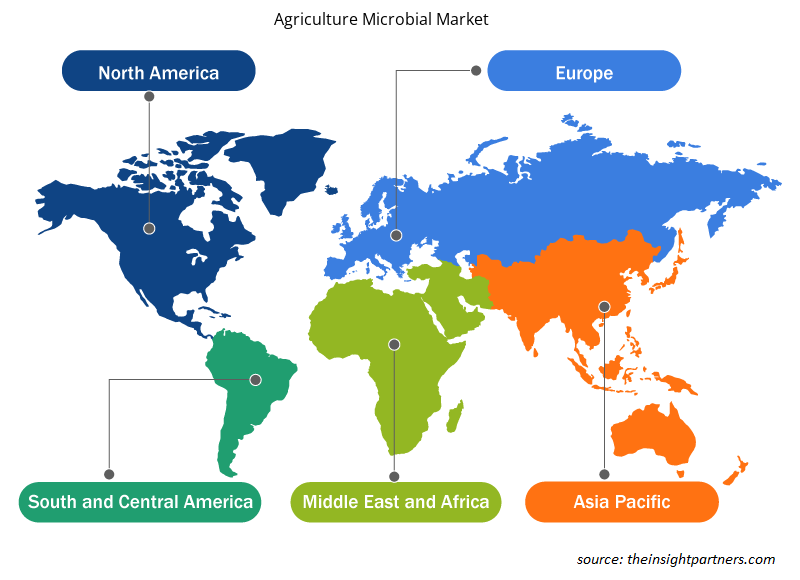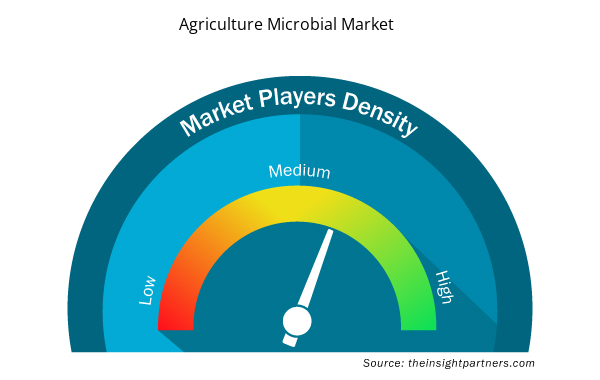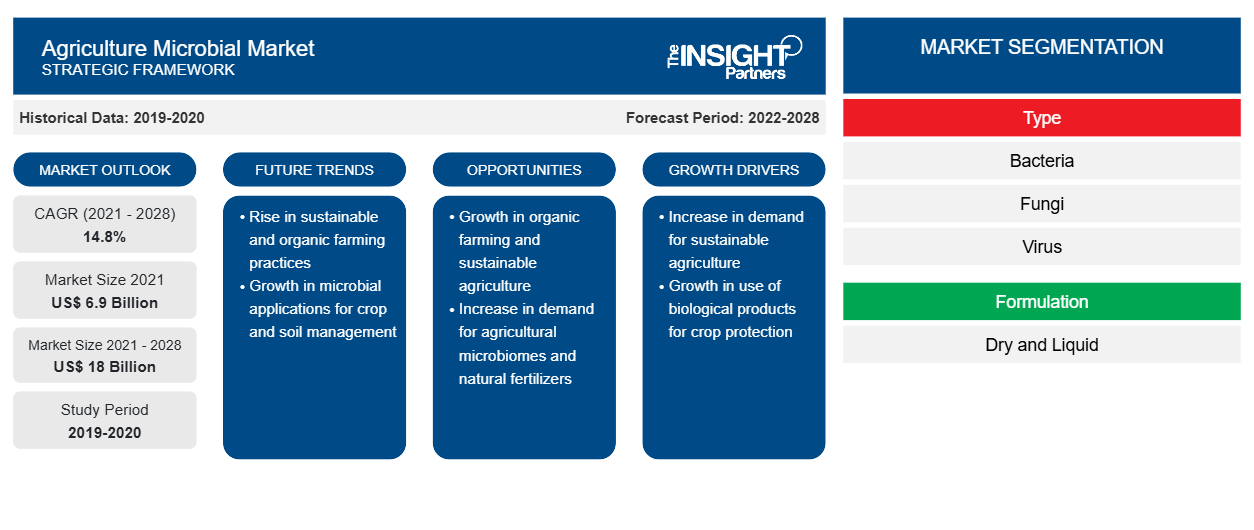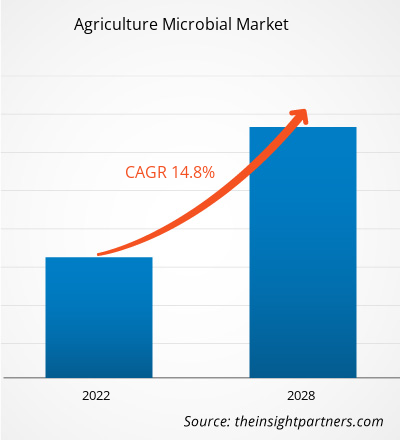農業微生物市場は2021年に69億193万米ドルと評価され、2022年から2028年にかけて14.8%のCAGRで成長すると予測されていると、インサイト・パートナーズは述べている。
農業微生物とは、作物の生産性と収穫量の品質を高めるために農業で使用される微生物を指します。細菌、真菌、ウイルスは、いくつかの微生物です。それらは、栄養分へのアクセスを改善することで植物の成長を促進します。多くの微生物は、有機物の分解と農業廃棄物のリサイクルに役立ちます。また、リン、窒素、その他の栄養素を提供し、耐熱性、耐干ばつ性、昆虫や植物病への耐性などの利点をもたらします。
2020年、北米は世界の農業微生物市場で最大のシェアを占め、アジア太平洋地域は予測期間中に最高のCAGRを記録すると予測されています。北米は、農業において合成化学物質よりも微生物を使用する利点についての認識が高まっているため、市場にとって最も重要な地域の1つです。合成化学物質は害虫耐性を発達させ、作物の生産に害を及ぼすため、使用が無効になります。農業微生物は実用的で、少量でも分解が速いため、曝露が少なくなり、合成化学物質によって引き起こされる環境問題を防ぎます。
さらに、環境に優しい有機農業の実践の増加が、微生物農業市場の成長を牽引しています。米国農務省(USDA)の2019年有機調査によると、2019年の米国には16,585の有機農場があり、2016年から16.7%増加しました。
要件に合わせてレポートをカスタマイズする
このレポートの一部、国レベルの分析、Excelデータパックなど、あらゆるレポートを無料でカスタマイズできます。また、スタートアップや大学向けのお得なオファーや割引もご利用いただけます。
- このレポートの主要な市場動向を入手してください。この無料サンプルには、市場動向から見積もりや予測に至るまでのデータ分析が含まれます。
COVID-19パンデミックが農業微生物市場に与える影響
COVID-19パンデミック以前は、農業微生物市場は主に有機農業の採用の増加と持続可能な農業への需要の高まりによって牽引されていました。しかし、2020年のパンデミックにより、多くの業界が前例のない課題に直面しました。農業業界は、いくつかの製造ユニットの閉鎖とサプライチェーンの混乱により衰退しました。しかし、2021年には、政府が以前に課された制限の緩和を発表したため、さまざまな経済が活動を再開し、世界市場にプラスの影響を与えました。さらに、メーカーはフル稼働を許可されたため、需要と供給のギャップを克服するのに役立ちました。現在、市場の状況は以前よりもはるかに良好です。多くの国でワクチン接種が完全に完了しており、農業微生物製品メーカーは収益を増やすために生産を増やすことに注力しています。
製造部門の労働力不足と、それに続くロックダウンと店舗閉鎖による販売店や小売店を通じた店内販売の中断により、農業微生物市場は抑制された。COVID-19パンデミックにより大きな打撃を受けたにもかかわらず、いくつかの企業は、2020年末までに業界で持続可能な農産物の需要が増加したと報告した。しかし、農産物の不足が拡大したため、各国政府は食糧需要を満たすために農産物に対する規制を緩和した。
市場分析
有機農業の導入増加が農業微生物市場を牽引
過去数年にわたり、持続可能性を実現し、環境への有害な影響を低減するために、有機農業が世界的に採用されてきました。土壌浸食の減少、地下水と表層水への硝酸塩の浸出の減少、農場での動物の排泄物のリサイクル使用は、有機農業の利点の一部です。利点に対する認識が高まるにつれて、有機農業の実践に対する需要が急増しています。国立農業統計局が実施した2019年の有機調査によると、米国では、2016年から2019年の間に認定有機農場が17%増加しました。国連食糧農業機関(FAO)によると、2019年には187か国で有機農業が実践され、約7,230万ヘクタールの農地が有機的に管理されていました。発展途上国のいくつかの政府は、有機農業の採用を強く重視しています。農業微生物は、合成成分で置き換えることができないため、土壌管理のための有機農業で重要な役割を果たします。土壌微生物(細菌、真菌、ウイルスなど)は、土壌において、作物の残留物の分解、窒素や炭素などの重要な栄養素の循環、植物の成長の促進など、基本的な機能を果たします。したがって、有機農業の導入が増えると、有機農業における利点から、農業微生物の需要が高まります。
タイプインサイト
農業微生物市場は、種類別に、細菌、真菌、ウイルス、その他に分類されます。予測期間中、細菌セグメントは最大の市場シェアと最高のCAGRを保持すると予想されます。真菌は、有機物を分解し、廃棄植物材料をリサイクルするための重要な土壌微生物の1つです。さらに、水分動態、栄養循環、病気の抑制に関連する重要な機能を果たします。たとえば、真菌の菌糸は土壌粒子と物理的に結合して安定した凝集体を形成し、植物の土壌水分保持能力と水の浸透を高めるのに役立ちます。
処方に関する洞察
農業微生物市場は、配合に基づいて乾燥と液体に分けられます。予測期間中、液体セグメントはより大きな市場シェアを占めると予想されますが、乾燥セグメントは2021年から2028年にかけてより高いCAGRを記録すると予測されています。液体セグメントの市場は、適用の容易さから成長しています。製品の液体配合は、灌水、スプレー、根の浸漬で直接使用できるため、乾燥形態の農業微生物よりも便利です。また、混合などの追加手順を必要としないため、製品の腐敗や無駄を防ぐことができます。
機能の洞察
機能に基づいて、農業微生物市場は作物保護と土壌改良に分かれています。作物保護セグメントは2020年に大きな市場シェアを占めました。農業微生物は、根、種子、果実、および作物の他の部分を保護するために使用できます。作物保護製品には、より小さな面積での生産の増加、環境の保護、より高い収量、および食品のコストの削減など、さまざまな利点があります。これらの利点により、作物保護製品の採用が増加しています。微生物による害虫防除は、生態学的安全性とかなりのターゲット特異性を提供するため、害虫管理制御プログラムが好まれます。
アプリケーションインサイトのモード
適用方法に基づいて、農業微生物市場は、葉面散布、土壌処理、種子処理、収穫後に分類されます。葉面散布セグメントは、2020年に最大の市場シェアを占めました。葉面散布で施用された栄養素は、他の技術で施用された場合よりも急速に吸収されます。葉面散布を使用すると、労働コストと機械コストが削減され、作物の生産コストが最小限に抑えられます。これらの技術は、植物の欠乏や病気の迅速な修正治療として機能します。
作物の種類に関する洞察
作物の種類に基づいて、農業微生物市場は、穀類と穀物、油糧種子と豆類、果物と野菜、その他に分類されます。果物と野菜のセグメントは、2020年に最大の市場シェアを占めました。このセグメントの市場成長は、作物に関連する高い報酬要因と、必須栄養素を効果的に提供する需要の増加に起因しています。さらに、有機果物と野菜の需要の増加は、農業微生物の必要性を促進します。
BASF SE、Bayer AG、Certis USA LLC、BioWorks、Novozymes A/S、Chr. Hansen Holding A/S、Syngenta Group、Nufarm、Marrone Bio Innovations、Inc.、およびKoppert BVは、農業微生物市場で活動している主要な企業です。これらの企業は、世界中で高まる消費者の需要を満たすために、新製品の発売と地理的拡大に重点を置いています。これらの企業は、世界中に広く展開しており、世界中の大規模な顧客にサービスを提供し、その結果、市場シェアを拡大しています。これらの市場プレーヤーは、新製品の発売と地域拡大に重点を置いて、専門ポートフォリオの製品範囲を拡大しています。
農業微生物市場地域別インサイト
予測期間を通じて農業微生物市場に影響を与える地域的な傾向と要因は、Insight Partners のアナリストによって徹底的に説明されています。このセクションでは、北米、ヨーロッパ、アジア太平洋、中東、アフリカ、南米、中米にわたる農業微生物市場のセグメントと地理についても説明します。

- 農業微生物市場の地域別データを入手
農業微生物市場レポートの範囲
| レポート属性 | 詳細 |
|---|---|
| 2021年の市場規模 | 69億米ドル |
| 2028年までの市場規模 | 180億米ドル |
| 世界のCAGR(2021年~2028年) | 14.8% |
| 履歴データ | 2019-2020 |
| 予測期間 | 2022-2028 |
| 対象セグメント | タイプ別
|
| 対象地域と国 | 北米
|
| 市場リーダーと主要企業プロフィール |
|
農業微生物市場のプレーヤー密度:ビジネスダイナミクスへの影響を理解する
農業微生物市場は、消費者の嗜好の変化、技術の進歩、製品の利点に対する認識の高まりなどの要因により、エンドユーザーの需要が高まり、急速に成長しています。需要が高まるにつれて、企業は提供を拡大し、消費者のニーズを満たすために革新し、新たなトレンドを活用し、市場の成長をさらに促進しています。
市場プレーヤー密度とは、特定の市場または業界内で活動している企業または会社の分布を指します。これは、特定の市場スペースに、その市場規模または総市場価値に対してどれだけの競合相手 (市場プレーヤー) が存在するかを示します。
農業微生物市場で事業を展開している主要企業は次のとおりです。
- BASF SE
- バイエルAG
- セルティスUSA LLC
- バイオワークス
- ノボザイムズA/S
免責事項:上記の企業は、特定の順序でランク付けされていません。

- 農業微生物市場のトップキープレーヤーの概要を入手
レポートの注目点
- 農業微生物市場における進歩的な業界動向は、企業が効果的な長期戦略を策定する上で役立ちます。
- 先進国と発展途上国の農業微生物市場のプレーヤーが採用しているビジネス成長戦略
- 2020年から2028年までの市場の定量分析
- 作業服の世界需要の推定
- 農業微生物市場におけるバイヤーとサプライヤーの有効性を示すポーターの5つの力の分析
- 競争市場の状況を理解するための最近の動向
- 農業微生物市場の成長を牽引・抑制する要因と市場動向および展望
- 商業的利益を支える市場戦略を強調することで意思決定プロセスを支援する
- さまざまなノードにおける農業微生物市場の規模
- 詳細な概要と作業服業界の動向
- 有望な成長機会のあるさまざまな地域の農業微生物市場の規模
- 過去2年間の分析、基準年、CAGRによる予測(7年間)
- PEST分析とSWOT分析
- 市場規模価値/数量 - 世界、地域、国
- 業界と競争環境
- Excel データセット


- Print Management Software Market
- Latent TB Detection Market
- Biopharmaceutical Tubing Market
- Micro-Surgical Robot Market
- Underwater Connector Market
- Sterilization Services Market
- Medical Devices Market
- Employment Screening Services Market
- Environmental Consulting Service Market
- Passport Reader Market

Report Coverage
Revenue forecast, Company Analysis, Industry landscape, Growth factors, and Trends

Segment Covered
This text is related
to segments covered.

Regional Scope
North America, Europe, Asia Pacific, Middle East & Africa, South & Central America

Country Scope
This text is related
to country scope.
よくある質問
According to the United Nations, the world population is expected to reach 9.8 billion in 2050 and estimated that it will reach 11.2 billion in 2100. With increased population, the global agriculture has to double food production by 2050 and reduce the reliance on inorganic fertilizers and pesticides. Thus, growing population has surged the demand and concerns for food to feed the growing population. Additionally, in recent years the food insecurity has been moderate which has affected more than 30% world population. According to the Food and Agriculture Organization in the US, in 2020 between 720 and 811 people faced hunger globally. The prevalence of undernourishment had climbed to around 9.9% in 2020 from 8.4% in 2019. Growing food scarcity and increasing population has surged the demand for sustainable and environmentally friendly agricultural products. Agriculture microbials are aiding numerous practices such as soil improvement and crop protection. Adoption of agriculture microbials offers various benefits such as increased nutrient uptake, crop yield, and organic cultivation. Such benefits offered by agriculture microbials coupled with ever growing population has surged the demand for agriculture microbials.
Based on the crop type, fruits and vegetables segment is projected to grow at the fastest CAGR over the forecast period. The growth is attributed to the high remuneration factors associated with the crop and increased demand to provide essential nutrients effectively. Further, the demand for agriculture microbial fruits and vegetables has surged due to increased demand for organic fruits and vegetables. For instance, according to the Government of Canada, the certified organic fruits and vegetables cultivated area in Canada increased 8.2% to 19,506 hectares in 2020.
North America accounted for the largest share of the global workwear market. North America is one of the most significant regions for the agriculture microbial market due to increasing awareness about the benefits of using microbial in agriculture over synthetic chemicals. The use of synthetic chemicals becomes ineffective as they develop pest resistance and harm the production of the crop. Agriculture microbial are practical and are quick to decompose even applied in small quantities, which leads to lower exposure and prevents the environmental problems of synthetic chemicals.
Based on formulation, liquid segment mainly has the largest revenue share. The liquid formulation of products is more convenient than the dry form of agriculture microbial as they can be directly used as drenches, sprays, and root dips. Also, they do not require additional procedures such as mixing, which help to avoid spoilage and wastage of the product. In addition, some benefits of the liquid form of the products offered benefits such as improved crop response from accuracy and availability of nutrients, providing nutrients by the need of plants, and these products can be applied accurately and evenly right up to the field edge.
The major players operating in the global agriculture microbial market are BASF SE; Bayer AG; Certis USA LLC; BioWorks; Novozymes A/S; Chr. Hansen Holding A/S.; Syngenta Group; Nufarm; Marrone Bio Innovations, Inc.; and Koppert B.V.
Agriculture microbials are gaining popularity across the globe due to its various advantages offered for crop protection and soil amendments. Bacteria, fungi, virus, and amongst others are some of the common microbial used in agricultural products to improve crop protection and increase crop yield. This has resulted in research and development activities to study the strains of various microbials. Prominent players such as Bayer AG, Syngenta, BASF SE, and others are engaged in research and development activities in order to study and develop microbial strains. For instance, Bayer AG is engaged in studying and experimenting various microbial strains to improve the crop protection and improve the yield of crops in the field. Every year, researchers at Bayer AG screen more than 10,000 microbes in vitro to study and develop useful strains for agriculture use.
Trends and growth analysis reports related to Chemicals and Materials : READ MORE..
The List of Companies - Agriculture Microbial Market
- BASF SE
- Bayer AG
- Certis USA LLC
- BioWorks
- Novozymes A/S
- Chr. Hansen Holding A/S.
- Syngenta Group
- Nufarm
- Marrone Bio Innovations, Inc.
- Koppert B.V.
The Insight Partners performs research in 4 major stages: Data Collection & Secondary Research, Primary Research, Data Analysis and Data Triangulation & Final Review.
- Data Collection and Secondary Research:
As a market research and consulting firm operating from a decade, we have published and advised several client across the globe. First step for any study will start with an assessment of currently available data and insights from existing reports. Further, historical and current market information is collected from Investor Presentations, Annual Reports, SEC Filings, etc., and other information related to company’s performance and market positioning are gathered from Paid Databases (Factiva, Hoovers, and Reuters) and various other publications available in public domain.
Several associations trade associates, technical forums, institutes, societies and organization are accessed to gain technical as well as market related insights through their publications such as research papers, blogs and press releases related to the studies are referred to get cues about the market. Further, white papers, journals, magazines, and other news articles published in last 3 years are scrutinized and analyzed to understand the current market trends.
- Primary Research:
The primarily interview analysis comprise of data obtained from industry participants interview and answers to survey questions gathered by in-house primary team.
For primary research, interviews are conducted with industry experts/CEOs/Marketing Managers/VPs/Subject Matter Experts from both demand and supply side to get a 360-degree view of the market. The primary team conducts several interviews based on the complexity of the markets to understand the various market trends and dynamics which makes research more credible and precise.
A typical research interview fulfils the following functions:
- Provides first-hand information on the market size, market trends, growth trends, competitive landscape, and outlook
- Validates and strengthens in-house secondary research findings
- Develops the analysis team’s expertise and market understanding
Primary research involves email interactions and telephone interviews for each market, category, segment, and sub-segment across geographies. The participants who typically take part in such a process include, but are not limited to:
- Industry participants: VPs, business development managers, market intelligence managers and national sales managers
- Outside experts: Valuation experts, research analysts and key opinion leaders specializing in the electronics and semiconductor industry.
Below is the breakup of our primary respondents by company, designation, and region:

Once we receive the confirmation from primary research sources or primary respondents, we finalize the base year market estimation and forecast the data as per the macroeconomic and microeconomic factors assessed during data collection.
- Data Analysis:
Once data is validated through both secondary as well as primary respondents, we finalize the market estimations by hypothesis formulation and factor analysis at regional and country level.
- Macro-Economic Factor Analysis:
We analyse macroeconomic indicators such the gross domestic product (GDP), increase in the demand for goods and services across industries, technological advancement, regional economic growth, governmental policies, the influence of COVID-19, PEST analysis, and other aspects. This analysis aids in setting benchmarks for various nations/regions and approximating market splits. Additionally, the general trend of the aforementioned components aid in determining the market's development possibilities.
- Country Level Data:
Various factors that are especially aligned to the country are taken into account to determine the market size for a certain area and country, including the presence of vendors, such as headquarters and offices, the country's GDP, demand patterns, and industry growth. To comprehend the market dynamics for the nation, a number of growth variables, inhibitors, application areas, and current market trends are researched. The aforementioned elements aid in determining the country's overall market's growth potential.
- Company Profile:
The “Table of Contents” is formulated by listing and analyzing more than 25 - 30 companies operating in the market ecosystem across geographies. However, we profile only 10 companies as a standard practice in our syndicate reports. These 10 companies comprise leading, emerging, and regional players. Nonetheless, our analysis is not restricted to the 10 listed companies, we also analyze other companies present in the market to develop a holistic view and understand the prevailing trends. The “Company Profiles” section in the report covers key facts, business description, products & services, financial information, SWOT analysis, and key developments. The financial information presented is extracted from the annual reports and official documents of the publicly listed companies. Upon collecting the information for the sections of respective companies, we verify them via various primary sources and then compile the data in respective company profiles. The company level information helps us in deriving the base number as well as in forecasting the market size.
- Developing Base Number:
Aggregation of sales statistics (2020-2022) and macro-economic factor, and other secondary and primary research insights are utilized to arrive at base number and related market shares for 2022. The data gaps are identified in this step and relevant market data is analyzed, collected from paid primary interviews or databases. On finalizing the base year market size, forecasts are developed on the basis of macro-economic, industry and market growth factors and company level analysis.
- Data Triangulation and Final Review:
The market findings and base year market size calculations are validated from supply as well as demand side. Demand side validations are based on macro-economic factor analysis and benchmarks for respective regions and countries. In case of supply side validations, revenues of major companies are estimated (in case not available) based on industry benchmark, approximate number of employees, product portfolio, and primary interviews revenues are gathered. Further revenue from target product/service segment is assessed to avoid overshooting of market statistics. In case of heavy deviations between supply and demand side values, all thes steps are repeated to achieve synchronization.
We follow an iterative model, wherein we share our research findings with Subject Matter Experts (SME’s) and Key Opinion Leaders (KOLs) until consensus view of the market is not formulated – this model negates any drastic deviation in the opinions of experts. Only validated and universally acceptable research findings are quoted in our reports.
We have important check points that we use to validate our research findings – which we call – data triangulation, where we validate the information, we generate from secondary sources with primary interviews and then we re-validate with our internal data bases and Subject matter experts. This comprehensive model enables us to deliver high quality, reliable data in shortest possible time.


 このレポートの無料サンプルを入手する
このレポートの無料サンプルを入手する